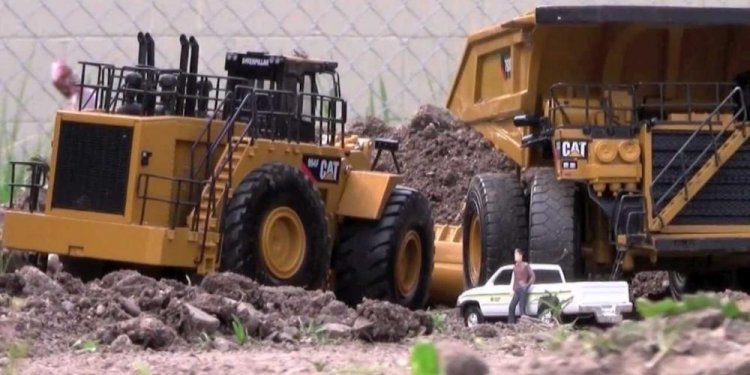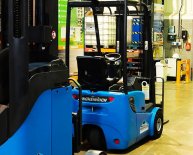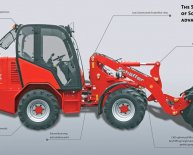
Check out the machine you're going to operate. There are two obvious reasons for doing this: one is so you're familiar with the machine, and the other is to make sure it is suitable for the job.
Look at the location of the operator's controls, understanding that the machine is operated from a forward and backward facing position.
Facing forward, you will see a steering wheel, shifter, front loader control lever, brake pedals (left and right independent brakes), gas pedal, and control switches for accessories like lights, emergency flashers, horn, emergency brake actuator, ignition switch, gauges, and other items. From this position, a backhoe looks very similar to other tractors.
Facing the rear (the seat swivels 180 degrees), you should see the boom controls. There are two different boom control configurations, the three stick that includes foot controls to swing the bucket, and the joystick controls, that operate all the backhoe boom controls with two joysticks. Also, there will be two auxiliary controls, either mounted paired on one side of the seat, or in front of the boom control sticks, that raise and lower the stabilizers.
Look at the safety equipment. Experienced backhoe operators check the safety equipment at the beginning of each shift to make sure it is in good condition. This requires some knowledge of how the safety equipment works, but even a novice should be able to observe things like the seat belt condition, the fire extinguisher charge, and be able to see obvious damage such as cracked members in the rollover protection system and missing guards.
Look at the general condition of the machine. Check the tires to make sure they are properly inflated and show no outward signs of damage, look for oil leaks, damaged hydraulic hoses, and other obvious signs of abuse or dangerous conditions.
Look at the size of the machine. Backhoes range in size from small attachments for lawn tractors, to machines weighing over 12, 000 pounds with turbo-charged diesel engines. You will have to decide how large a machine you will need to perform the project you have in mind.
Look at other features of the machine you will operate, like air conditioning, four wheel drive, extend-a-hoes, and the various special attachments available on these machines.
Read the operator's manual of the machine you will operate.
Check the tires to make sure they are properly inflated and show no outward signs of damage, look for oil leaks, damaged hydraulic hoses, and other obvious signs of abuse or dangerous conditions.
Look at the size of the machine. Backhoes range in size from small attachments for lawn tractors, to machines weighing over 12, 000 pounds with turbo-charged diesel engines. You will have to decide how large a machine you will need to perform the project you have in mind.
Look at other features of the machine you will operate, like air conditioning, four wheel drive, extend-a-hoes, and the various special attachments available on these machines.
Read the operator's manual of the machine you will operate. There are substantial differences in backhoes, from the location of controls to the actual cranking procedure and the gauge cluster location. Obviously, this article is general in nature and doesn't cover every make and model of backhoes; each backhoe has its own features with which you should be familiar. Climb up on the machine you have chosen. Sit down in the seat, buckle the seat belt, and take a long, slow look around to see what the clearances of the different different parts of the machine are, and where the various controls are located. Avoid dry runs on the controls, as many parts may move when levers or controls are moved, even if the engine is not running.
Crank the engine, allowing it to warm up for a few minutes before attempting to engage the transmission or operating any controls. This warming-up time will ensure that the hydraulic fluid will begin to circulate and warm up.
Check to make sure all attachments are clear of the ground, including the stabilizers, the front bucket, and the backhoe boom. If you need to raise them to allow the machine to be driven, use the controls delicately until you have a feel for them. This is especially true of the back boom, since raising or swinging it without the stabilizers down can shake the tractor violently.
This warming-up time will ensure that the hydraulic fluid will begin to circulate and warm up.
Check to make sure all attachments are clear of the ground, including the stabilizers, the front bucket, and the backhoe boom. If you need to raise them to allow the machine to be driven, use the controls delicately until you have a feel for them. This is especially true of the back boom, since raising or swinging it without the stabilizers down can shake the tractor violently.
Release the parking brake, and shift the transmission into forward, then drive it slowly around while you get the hang of steering and braking the machine. Running in low or second gear while practice driving the machine is a good idea; even experienced operators only use third or high gear on very smooth, flat surfaces, since the balance of the machine makes it difficult to steer at high speeds.
Raise and lower the front end loader bucket (if equipped) to get the feel of it. The control lever for this attachment is located on the operator's left while sitting facing forward. Pulling straight toward the rear raises the bucket, pushing straight forward lowers it, pulling it toward the center of the machine scoops, and pushing outward dumps it.
Pulling straight toward the rear raises the bucket, pushing straight forward lowers it, pulling it toward the center of the machine scoops, and pushing outward dumps it.
Make sure you have plenty of clearance both to the rear and the sides of the machine, since the boom swings left and right 180 degrees, and has a reach of up to 18 feet (5.4 meters).
Set the throttle to rev the engine to about 850 Rotations Per Minute (not too fast until you get the hang of the controls).
10
Lower the stabilizers until they raise the rear of the tractor so the back wheels no longer touch the ground, then lower the front bucket to its limit, raising the front wheels also. You may find you have to lower one stabilizer further than the other to level the rear of the machine, depending on whether you're on a slope, or if the soil is less stable on one side than the other.
11
Unlock the back boom. Do this by pulling forward (toward you, and the front of the tractor) on the left control lever, then pushing if away from you when it pauses at the highest point, while holding the unlocking lever (usually on the right floor board) with your foot.
12
Push the left lever further outward after the boom is unlocked to lower the main boom, or nearest section of the backhoe boom. Push outward on the right lever to extend the lower boom (outer section, with the bucket attached) away from you (this will actually raise the second boom) so that the bucket is extending outward.
13
Push the left lever to lower the boom into the soil, while pulling the right lever to drag the bucket into the soil in a scooping motion, then begin rolling the bucket forward by moving the right control lever to the left. You will find with practice that you start to coordinate these movements, to achieve a fluid movement of the backhoe.
14
Raise the boom with the left control arm by pulling it. Usually you raise the bucket with the right control by swinging it to your left to keep it filled while you lift it from the hole.
See also:
Source: www.wikihow.com

 Check out the machine you're going to operate. There are two obvious reasons for doing this: one is so you're familiar with the machine, and the other is to make sure it is suitable for the job.
Check out the machine you're going to operate. There are two obvious reasons for doing this: one is so you're familiar with the machine, and the other is to make sure it is suitable for the job.
 Check the tires to make sure they are properly inflated and show no outward signs of damage, look for oil leaks, damaged hydraulic hoses, and other obvious signs of abuse or dangerous conditions.
Check the tires to make sure they are properly inflated and show no outward signs of damage, look for oil leaks, damaged hydraulic hoses, and other obvious signs of abuse or dangerous conditions. This warming-up time will ensure that the hydraulic fluid will begin to circulate and warm up.
This warming-up time will ensure that the hydraulic fluid will begin to circulate and warm up. Pulling straight toward the rear raises the bucket, pushing straight forward lowers it, pulling it toward the center of the machine scoops, and pushing outward dumps it.
Pulling straight toward the rear raises the bucket, pushing straight forward lowers it, pulling it toward the center of the machine scoops, and pushing outward dumps it.
















